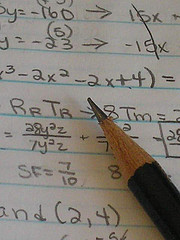It’s the No. 1 question asked of math teachers: “When will I ever use this stuff?”
And in terms of upper-level math — conic sections, radicals, differentiation and the quadratic formula — the answer may very well be, “Not much.” (Unless you’re in one of those jobs with top-paying degrees.)
As I hope you know by now, basic math is ubiquitous. We encounter percents, fractions, formulas, the order of operations (Please Excuse My Dear Aunt Sally) and geometry pretty regularly. But algebra? When was the last time you solved for x?
Algebra describes the relationships between values, and how those values change when we introduce variables. In short, algebra is based on equations or expressions:
3+x
x2+4x-7
y=5x+9
(Are your hands sweating or have your eyes glazed over? Hang in there. I promise this won’t be overwhelming.)
In its simplest form, algebra can be described as the process of solving for a variable. And you probably did that with random equations for a good portion of your high school math education.
Boring.
Except for word problems, none of the equations had much to do with real life, which is one way that we math educators have sucked all of the life out of math.
But I’m guessing that at least some of you use algebra pretty darned regularly–without even knowing it. Let me show you how.
As a freelance writer, I’m responsible for maintaining my business records, which for me include expected and actual income, invoices and goals. I could purchase accounting software for this or hire someone to do the work for me, but to be honest, my business is pretty small. I have a lot of experience with spreadsheets, and so six years ago, I built one that I still use to track all of my business finances and goals.
Why does this work? Formulas. One formula gives me the total of all of my invoices for each month and and another spits out the percent those are of my monthly goal. I have created formulas that give the percent of my income that is generated from each of my revenue streams. And because of formulas, I can instantly see how much income has been invoiced but not received.
But maybe this isn’t such a great example. Most small businesses or self-employed folks use ready-made accounting programs for these tasks.
Meet my good friend, Rebecca. Like many of us in my neighborhood, Rebecca’s family gets milk delivered once a week by a local dairy. (I know! Cool, right?) But unlike me, she shares her delivery with her next-door neighbor. And that requires a little bit of math. Here’s how she explains it:
As you know there are bottle deposits, bottle charges, delivery charges and of course milk (or other product) charges. The charges go to only one credit card. Keeping track of these is a challenge if you don’t want to have to write a check to your neighbor every week – and who wants that? So we have worked out a “kitty” (nice, eh, milk – kitty. ha ha) system where we pay a lump sum to the person whose credit card is being charged. But then we have to know when the kitty is running out.
In other words, each of the families contributes to the kitty, and those funds are used to pay the milk bill on one family’s credit card account. Rebecca uses a spreadsheet to keep up with how much money is in the kitty at any given time. When the kitty runs low, she knows to ask her neighbor for a contribution.
Rebecca’s milk delivery spreadsheet
Why doesn’t Rebecca ask for the same monthly payment in the kitty? Well, this is where the algebra comes in. Not only can we order milk, but also yogurt, meats, eggs and cheese. That means the weekly orders vary. And — here’s where you can use that English degree — when elements vary, they’re called variables.
Ta-da! Algebra in real life. (Gosh, I’m so proud!)
These spreadsheet formulas are so useful that algebra teachers are using them to demonstrate how algebra is indeed useful in everyday situations.
So, when was the last time you used a spreadsheet? Did you create a formula? Did you know you were using algebra? Tell us about it in the comments section.

